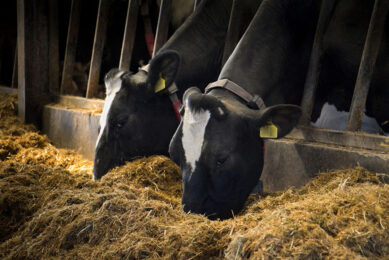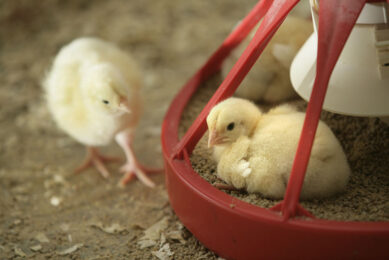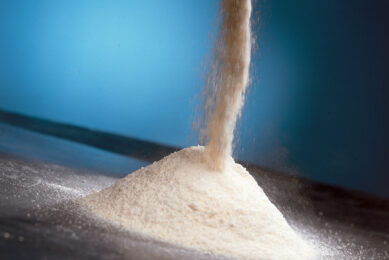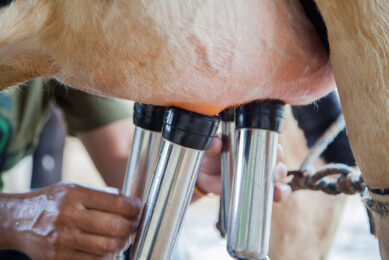Don’t save on milk powder quantity

The rearing strategy for heifer calves depends on the farmer’s goals and includes questions such as, Do I need to focus on cost savings or on growth performance? According to Jo Heusschen, one thing is important to keep in mind: don’t save on milk powder, but also don’t feed too much.
Today’s high quality calf milk replacers, when correctly matched to the specific calf rearing systems, provide several benefits to the dairy producer and calf raiser. These benefits include improved biosecurity, calf performance and economics. Within the last 15 years, there have been significant changes in the formulation of milk replacers. When fed properly, high quality milk replacers will allow calf growth and performance equal or even greater than that attainable with whole milk. When rearing heifers it is of utmost importance to keep in mind which is the most important goal. Is your aim to realise maximal animal performance or is the aim to realise maximal profit for the farm? Both goals are of course interconnected; maximal animal performance leads to higher growth and less feed costs, which in turn makes the farm more profitable. For the calf’s milk period (the first 8-12 weeks after birth) saving costs can be done in two ways. Firstly, changing the quantity of milk replacers fed to the calves and secondly feeding different types of milk replacers to the calves.
Quantity of milk replacers
In January 1995, the Dutch Research Station for cattle, sheep and horse husbandry published an article about the relation between the growth of calves and the fed quantity of calf milk powder1. The growth of the calves that were fed 45 or 60 kg of calf milk powder was significantly higher than the calves that were fed 15 or 30 kg of calf milk powder2 (Table1). The group that received 15 kg of calf milk powder consumed more pelleted feed and roughage. However, this did not lead to the same or higher growth as the group which was fed 45 or 60 kg of calf milk powder. If you are targeting maximum growth of your calves in the milking phase, reducing the quantity of calf milk powder to a level of 30 kg or lower is disastrous. The calves will grow slower (930 versus 1,020 gr/calf/day), which means lower animal performance and even more chance on a longer rearing period (higher age at calving). Research in Israel3 confirmed this theory. Heifer calves which received more milk replacer during the milking phase have a higher milk production during the first lactation (+ 500 litres per heifer calf per year) and the second lactation. The results of this research are validated by other observations, e.g. in Germany4. The literature knows several cases which confirm the influence of the feeding strategy in the first weeks of life on the animal performance, and on the presence and absence of diseases (e.g. lung problems). These cases point out the fact that encouraging the maximal growth performances during the milking phases of the heifer calf can have a very positive effect on the first (and maybe every next) lactation period5.
From these data, it can be concluded that more kg of calf milk replacers lead to higher growth per animal per day (45 kg per calf is recommended during the first 8-12 weeks after birth). Secondly, a higher growth during the milking phase as a heifer calf can lead to higher milking performances in the lactation period.
Different types of milk replacers
The calf milk replacer containing 50% skimmed milk powder (SMP) is traditionally known as a high performing product for rearing calves. In 2007, milk ingredient prices increased extremely, especially the price of SMP. Less expensive calf milk replacers, based on concentrated whey proteins and high digestible vegetable proteins, have been on the market for many years; however these alternatives did not technically perform on the same level as the 50% SMP products. Schils bv in the Netherlands therefore developed and tested, in 2007 and 2008, a new type of milk replacer, which performs as a product with SMP, but with costs which are considerably lower. By using the latest knowledge on amino acid requirements and an unique spray drying production technology Schils created a new generation calf milk replacer which combines high performance, high nitrogen efficiency (18% protein compared to 21-23% protein in SMP-products) and lower costs (€24,- lower than 50% SMP-product6). This new milk replacer was tested to verify the effects on the calf’s growth performance as well as the effects on the calf’s feeding costs during the milking period. The summary of two trials (executed at the research farm of the VanDrie Group) is shown in Table 2 and 3. From these trials it could be concluded that if you want to achieve maximal growth per calf per day, a milk replacer with 50% skimmed milk powder is a very good choice. If you want to achieve the lowest feed costs while maintaining good performance, the new generation calf milk replacer would be the right choice.
Practical meanings
Research as mentioned above gives us some insights into how and how much milk replacer needs to be fed. But how can this information be translated into practice? Here we explain two examples, reflecting different dairy farmer’s objectives.
Farmer 1: Heifer’s age at calving is younger than 24 months and heifer’s milk production is aimed at maximal performance. If the farmer wants to achieve a calving age younger than 24 months, growth during the milking period is very important.
As indicated, the quantity and the quality of the calf milk replacer have a high impact on the calf’s technical performance. More milk replacer consumption (of high quality) will ensure maximal growth during the milking period. Moreover, more milk replacer consumption will also lead to a higher milk performance during the first (and second) lactation period. The best strategy for this farmer would be to feed at least 45 kg calf milk replacer of a high quality (e.g. with 50 % SMP) per calf during the milk period.
Farmer 2: Heifer’s age at calving is around 26 months of age and the farmer chooses for a strategy based on long life-cycle production of the heifer. This strategy reflects other managerial parameters than farmer 1: a good growth of the heifer calf but moreover a reduction of the costs. This farmer will probably not choose for the milk replacer which assures the highest growth. He will be more inclined to choose which milk replacer brings the best combination of minimising rearing costs together with good technical performance indicators. Therefore, this farmer is expected to choose for a milk replacer of good quality for a reasonable price, for example a new generation calf milk replacer. This farmer should feed 45 kg of milk replacer to achieve good growth. This farmer can choose between two strategies: 1) feed from beginning to end a new generation product for a reasonable price, or 2) feed by a phase feeding system: start feeding a premium quality (SMP) product in the first crucial weeks, followed by the new generation product for feeding from week 4 on. The farmer can choose between these strategies based on the importance of the cost reduction and the health parameters on the farm, e.g. death loss or lung problems in the first three weeks.
Conclusions
If you want to achieve maximal heifer growth during the milking period, do not save on milk powder quantity. Feeding 45 kg of calf milk replacers is recommended and showed the highest animal performance in the studies mentioned here. In terms of milk replacer quality, the type of milk replacer depends on the managerial goals of the farmer e.g. maximising growth or minimising feeding costs per kg of growth. If cost savings without losing performance is the main managerial goal, new generation milk replacers are an interesting option for the farmer.
These products are innovated in a way which distinguishes them less in performance from SMP products, but whose costs are considerably lower.
Contact: info@schils.com. References are available on request.
Feed Mix Vol. 17 No. 2, 2009











